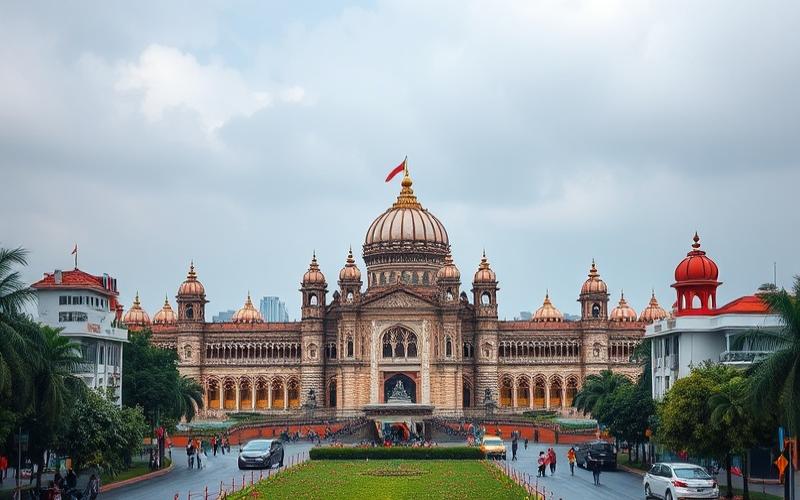
 Published on and written by Cyril Jarnias
Published on and written by Cyril Jarnias
Navigating early retirement procedures in India may seem complex, but understanding the essential conditions and potential benefits can transform this key milestone into a smooth and beneficial transition.
This guide explores eligibility criteria, required documents, and the various options offered by the Indian system to ensure a peaceful transition into retirement.
Deciphering these elements can not only enlighten workers nearing retirement but also provide a valuable overview for planning their future with peace of mind and financial security.
Steps to Apply for Early Retirement in India
Administrative Steps to Apply for Early Retirement in India:
- Check eligibility: must be at least 50 years old, cease all professional activity, have contributed at least 10 years to the relevant scheme, and convert at least 80% of accumulated funds into a monthly annuity.
- Complete the application form with the Employees’ Provident Fund Organisation (EPFO) or the appropriate sectoral body (e.g., seamen’s fund, agricultural fund for special schemes).
- Submit the application online via the EPFO portal or in person at the local EPFO office.
- Attach the required documents.
- Track the application processing via the portal or by contacting the relevant agency.
Required Documents for Application:
- Identity card (Aadhaar, passport, or other official ID)
- EPF (Provident Fund) account number
- Certificate of cessation of professional activity
- Career records and contribution certificates
- Bank details (account statement or canceled check copy)
- Identity photographs
- Completed application form (e.g., Form 10D for pension)
Competent Platforms or Organizations:
| Scheme Type | Submission Organization/Platform |
|---|---|
| General employee scheme | Employees’ Provident Fund Organisation (EPFO) – online portal or physical office |
| Special schemes (seamen, agriculture, etc.) | Relevant sectoral fund or dedicated agency |
| International application | Coordination via bilateral agreements, submission to the agency in the country of residence or EPFO in India |
Average Processing Time for Applications:
Generally, processing time ranges from 1 to 3 months from receipt of the complete file.
Delays may occur due to incomplete files or additional verifications, especially for international workers or special schemes.
Consultations with Retirement Advisors:
It is recommended to consult a retirement advisor, either within the company or through EPFO agencies, to ensure application compliance and optimization of benefits.
For complex situations (international careers, multiple schemes, bilateral agreements), the advice of an international social security expert is strongly advised.
Regional or Sectoral Specificities:
Procedures and documentation may vary by Indian state or sector of activity (e.g., agriculture, maritime, public sector).
Some sectoral funds have specific forms or requirements.
For foreign workers or expatriates, benefit recovery depends on bilateral social security agreements between India and the country of origin.
Applicant Feedback:
Users report that online submission via EPFO speeds up processing, but administrative delays sometimes persist, particularly for validating contribution years or document verification.
Main obstacles encountered: incomplete documentation, lack of knowledge about procedures, difficulties obtaining certain certificates from past employers.
Applicants who consulted an advisor or used EPFO agent assistance generally have more positive feedback on the simplicity and speed of the process.
Note:
– A reduction coefficient (4% per year of early retirement) applies if the application is submitted before age 58.
– For each year deferred beyond the legal age, a 4% increase is applied.
– The pension amount depends on the affiliation period and reference income.
Good to Know:
To apply for early retirement in India, it is crucial to prepare your file well by gathering the required documents such as your career record, pay stubs, and other proof of social contributions. The application can generally be made online via the EPFO (Employees’ Provident Fund Organisation) portal or directly through your employer, depending on your sector’s specifics. Processing time varies but is often a few months; it is advisable to start the process at least six months in advance. Consultation with a retirement advisor, while not mandatory, is recommended to better understand the impact on your finances and optimize your choices. In some states like Maharashtra, specific rules may apply, so inform yourself through local forums where many retirees share their experiences and practical advice, such as double-checking forms to avoid unnecessary delays.
Specific Conditions to Meet for Early Retirement
To qualify for early retirement in India, several specific conditions must be met depending on the professional sector, length of service, and minimum age required.
| Sector | Minimum Age Required | Service/Contribution Duration | Special Conditions |
|---|---|---|---|
| Civil Servants | 50 to 60 years | Generally ≥20 years of service | Some schemes allow departure after 20 years, sometimes as early as 50 or 55 years depending on central or state government rules. Special categories exist for armed forces (possible departure after 15-20 years). |
| Private Sector | Variable (often ≥55) | Generally ≥10 to 20 years of contribution | Subject to Employees’ Pension Scheme (EPS) and individual company policies. Workers may qualify for reduced retirement as early as age 50/55 if the minimum duration is met. |
| Disabled Workers / Strenuous Occupations | From 45-50 years | Variable duration, often relaxed | Early departure authorized under medical condition: disability rate recognized by official commission; retroactive validation of periods under disability possible. |
Main Eligibility Criteria:
Minimum age: generally between 50 and 60 years, but some schemes allow earlier departure for medical reasons or disabilities.
Minimum service or contribution duration:
- Public service: often ≥20 years.
- Private sector (EPS): typically between 10 and 20 years depending on the scheme.
Long careers: possibility of departure from 60/61/62/63/64/65 years if you justify a full career (typical example: departure from 60 years with at least 44 years).
List of Main Regulatory Requirements:
- Justify the minimum duration required by the chosen scheme.
- Provide documents proving worked/contributed time.
- In case of disability or incurable illness, provide an official medical certificate.
Recent Changes in Indian Early Retirement Legislation:
- Legal retirement age tends toward a gradual increase (66 years in February 2025, then 67 years from 2030) in all sectors.
- Relaxation for disabled workers: lowering the minimum recognized disability rate to qualify for the scheme.
List of Possible Penalties/Reductions:
- Amount reduced proportionally to the number of years short of the legal age (actuarial penalty on monthly pension).
- Limited access to ancillary benefits until reaching legal age.
Options to Maximize Benefits in Early Retirement:
- Accumulate more quarters/contributions before applying
- Check eligibility for special schemes related to disability/strenuous occupation
- Seek advice from the managing fund to optimize the final calculation
⚠️ For any early retirement application, it is imperative:
- To precisely verify the conditions set by your main fund;
- To anticipate the financial impact of applied reductions;
- To inquire about options potentially allowing employment-pension combination without limitation after reaching the revised legal age.
Good to Know:
To qualify for early retirement in India, it is crucial to meet certain specific conditions. First, the minimum required age generally ranges between 50 and 55 years, depending on the employment sector. For civil servants, 20 years of service are often required, while private sector employees must sometimes justify 10 to 15 years of contributions. Some professions, like police or armed forces, have special provisions, allowing early retirement after 15 years of service due to the demanding nature of their work. Indian government regulations, revised regularly, can affect these conditions, making it essential to stay informed about any recent legislation. Note that early retirement benefits may be reduced, often by 2% per year short of the standard retirement age. To maximize benefits, it is advisable to capitalize on additional contributions or slightly extend service where possible.
Benefits Offered to Early Retirees in India
Economic Benefits for Early Retirees in India
- Public Pensions: Early retirees can benefit from various public schemes, including the new “Pension Scheme 2025” which guarantees ₹3,500 per month to eligible citizens over 60, with direct deposit to bank account.
- Preferential Interest Rates: A new government product launched in 2025 offers a fixed interest rate of 11.68% for life for retirees, with no market risk and flexible payment options.
- Tax Exemptions:
- The income tax exemption limit has been raised to ₹12 lakh per year for retired individuals, making a large portion of retirement income non-taxable.
- Withdrawals from the National Savings Scheme (NSS) are now tax-exempt effective August 29, 2024.
- The threshold for no tax deducted at source (TDS) on interest (excluding securities) has doubled to ₹1 lakh, simplifying tax management of interest from deposits and savings accounts.
- Complementary Programs:
- NPS Vatsalya accounts receive the same tax treatment as the classic National Pension System.
- Specific aid is allocated through Atal Vayo Abhyuday Yojana (AVYAY) to support seniors’ financial well-being.
| Financial Benefit | Description | Conditions / Limits |
|---|---|---|
| Monthly Pension | ₹3,500 / month (Pension Scheme 2025) | Family income less than ₹3 lakh/year |
| Guaranteed Interest Rate | 11.68% for life (government product 2025) | Deposit cap of ₹15 lakh |
| Income Tax Exemption | Threshold at ₹12 lakh/year | For retirees over 60 years |
| NSS Withdrawal Exemption | 100% tax exemption | Applicable since August 2024 |
| TDS Threshold on Interest | Raised to ₹1 lakh (excluding securities) | For bank deposits and savings accounts |
“After my retirement in 2015, this is the first time I feel real relief thanks to this budget. The new tax thresholds and simplified withdrawals give me real financial security.”
— Dr. Savita Joshi, 72 years old, Indore
“The exemption on NSS withdrawals is a great relief for small traders like me.”
— SK Jain, 65 years old, Bhopal
“The EPF pension amount remains low, but the new savings products offer welcome stability.”
— A Srihari Rao, 65 years old, Telangana
Summary of Non-Financial Benefits:
- Dedicated health programs
- Social support (nutrition, housing, security)
- Training and cultural activities
- Community engagement (volunteering)
Recent Data: Measures announced in the 2025 Budget, such as raising tax thresholds and creating new guaranteed-rate products, are praised by beneficiaries, although some retirees feel that certain schemes, like EPF, still need improvements.
Good to Know:
In India, early retirees can take advantage of several economic and non-economic benefits that facilitate this transition. Financially, they have access to various pension options such as the National Pension System, which offers competitive interest rates. Additionally, specific tax reductions, like exemptions on certain income brackets, are granted, thus relieving their tax burden. On the non-financial side, early retirees benefit from social welfare programs and dedicated health facilities, often subsidized by the state, which reduces their medical expenses. Volunteering opportunities are available, allowing these individuals to remain active and socially engaged. Continuing education platforms, often supported by the government, offer the chance to learn new skills or retrain professionally, a boon for people wanting to give new life to their post-retirement lives. One testimony highlights a retiree who used his benefits to study yoga, thus turning his passion into a vocation, illustrating that these benefits can not only improve quality of life but also open new perspectives.
Disclaimer: The information provided on this website is for informational purposes only and does not constitute financial, legal, or professional advice. We encourage you to consult qualified experts before making any investment, real estate, or expatriation decisions. Although we strive to maintain up-to-date and accurate information, we do not guarantee the completeness, accuracy, or timeliness of the proposed content. As investment and expatriation involve risks, we disclaim any liability for potential losses or damages arising from the use of this site. Your use of this site confirms your acceptance of these terms and your understanding of the associated risks.




















































